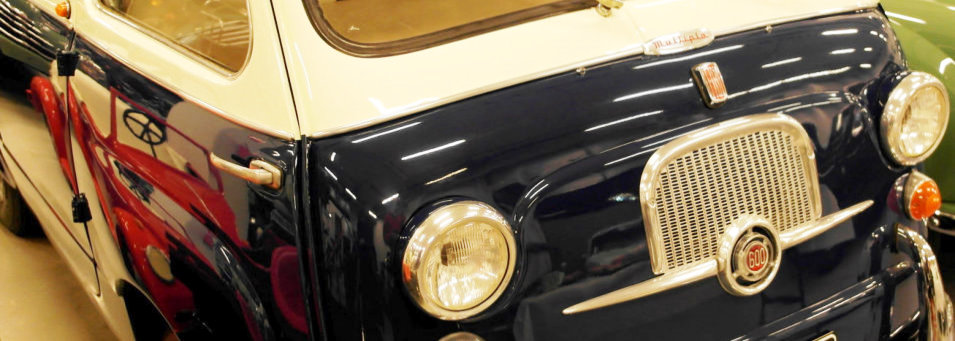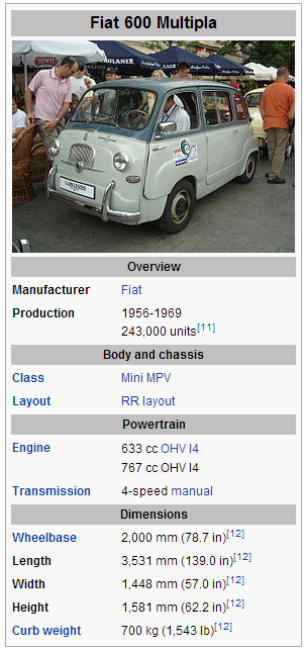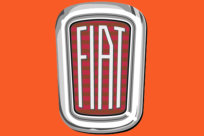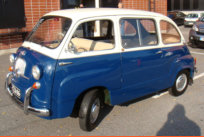




Until the 1970s, it was widely used as a taxi in many parts of Italy

Fiat Multipla - 65
The original Fiat 600 Multipla was based on the Fiat 600's
drivetrain, model 1100 coil and wishbone independent
front suspension, and sat six people in a footprint just 50
centimetres (19.7 in) longer than the original Mini Cooper.
The driver's compartment was moved forward over the
front axle, effectively eliminating the boot but giving the
body a very minivan-like "one-box" look. Behind the front
seat the vehicle could be arranged with a flat floor area
or a choice of one or two bench seats.
A 633 cc, RHD Multipla, was tested by the British magazine The Motor in 1956 and was found to have a top speed of 57.1 mph (91.9 km/h) and could accelerate from 0-50 mph (80 km/h) in 43.0 seconds. A fuel consumption of 38.4 miles per imperial gallon (7.36 L/100 km; 32.0 mpg-US) was recorded. The test car cost £799 including taxes on the UK market. In 1956, Fissore designed a remarkable open-topped Multipla prototype called the "Marinella" with a wooden-slat wraparound bench in the rear. A Fiat 600 Multipla towing a caravan is used in the video clip of the Crowded House hit Weather with You from their 1991 album Woodface. The Multipla name was re-introduced in the late-1990s, for the Fiat Multipla compact MPV.Origin
The Fiat 600 (Italian: Seicento) is a city car produced by the Italian manufacturer Fiat from 1955 to 1969. Measuring only 3.22 m (10 ft 7 in) long, it was the first rear-engined Fiat and cost the equivalent of about € 6,700 or US$ 7300 in today's money (590,000 lire then). The total number produced from 1955 to 1969 at the Mirafiori plant in Turin was 2,695,197. During the 1960s, '70s and '80s, the car became very popular in countries such as Spain (as SEAT 600), where it became the icon, par excellence, of the Spanish miracle, Argentina, where it was nicknamed Fitito (a diminutive of Fiat) and former Yugoslavia where it was nicknamed Fićo.Characteristics
The car had hydraulic drum brakes on all four wheels. Suspension was a unique single double- mounted leafspring - which acts as a stabilizer - between the front wheels coupled to gas- charged shock absorbers, and an independent coil-over-shock absorber setup coupled to semi- trailing arms at the rear. All 600 models had 3-synchro (no synchro on 1st) 4-speed transaxles. Unlike the Volkswagen Beetle or Fiat 500, the Fiat 600 is water-cooled with an ample cabin heater and, while cooling is generally adequate, for high-power modified versions a front- mounted radiator or oil cooler is needed to complement the rear-mounted radiator. All models of the 600 had generators with mechanical external regulators. The top speed ranged from 95 km/h (59 mph) empty with the 633 cc inline-four engine to 110 km/h (68 mph) with the 767 cc version. The car had good ventilation and defrosting systems. A year after its debut, in 1956, a soft-top version was introduced, as well as a six-seater variant — the Fiat 600 Multipla. It was a precursor of current multi-purpose vehicles. Retrospectively the water-cooled Fiat 600 is sometimes over-shadowed by the air-cooled Fiat 500, but the 600 was a remarkably fast seller in its time: the millionth 600 was produced in February 1961, less than six years after the car's launch. At the time when the millionth car was produced, the manufacturer reported it was producing the car at the then remarkable rate of 1,000 a day. As of 2011 there are only 65 left in the UK that are road legal.
1965
Engine 767 cc 4 cylinders Power 29 HP Top speed 115 km/h Lenght/width 3,53 m/1,45 m Weight 750 kg
Photos mainly by Matti Kreivilä. Historical facts and technical details of the vehicles provided by Wikipedia. Movies YouTube.



- Autobianchi Transformable - 1960
- Autobianchi Familiare - 1962
- Autobianchi Panoramica - 1962
- Autobianchi Cabriolet - 1963
- BMW Isetta 300 - 1956
- BMW Isetta 300 - 1959
- BMW Isetta Standard
- BMW 600 - 1959
- Bond Bug ES 700 - 1973
- Fiat Topolino - 1936
- Fiat Topolino - 1939
- Fiat Topolino - 1951
- Fiat Belvedere - 1952
- Fiat Topolino - 1954
- Fiat 600 - 1955
- Fiat 500 - 1963
- Fiat 500 - 1969
- Fiat Multipla - 1965
- Fuldamobil 4-wheel - 1958
- Fuldamobil King S7 - 1959
- GLAS Isar T700 - 1962
- Goggomobil T400 - 1959
- Goggomobil T250 - 1961
- Goggomobil T250 - 1969
- Goggomobil Coupe
- Heinkel Kabine - 1959
- Honda N600 - 1970
- Jalta Saporoshez - 1967
- Lloyd Alexander TS - 1960
- Messerschmitt KR200 - 1960
- Messerschmitt KR201
- Messerschmitt KR200 - 1963
- Messerschmitt KR200 - 1964
- NSU Prinz I - 1958
- Scootacar Mk3 - 1963
- Steyr-Puch 500 -1961
- Steyr-Puch 650 - 1964
- Trabant P 50 - 1961
- Trojan 603/198 - 1964
- Trojan 3-wheeler - 1964
- Trojan 3-wheeler - 1964
- Vespa 400 - 1959
- Victoria Spatz 250 - 1957
- ZŁndapp Janus - 1959


- About Scooters
- Apollo moped
- Cezeta 175 - 1960
- Heinkel Tourist - 1960
- Lambretta 125 - 1953
- Puch SR 150 - 1958
- Pyrkijš moped
- Suzuki Burgman 400
- Tunturi City - 1980
- Vespa 150 - 1959
- Yamaha Passola 50 - 1980
- ZŁndapp Bella w. sidecar - 1960
- ZŁndapp Bella 204 - 1960
- ZŁndapp Bella 200 Deluxe - 1963
- ZŁndapp Combinette




















